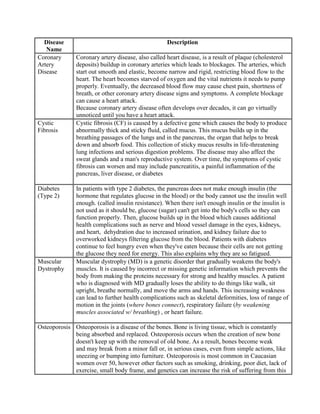
Disease handout
- 1. Disease Name Coronary Artery Disease Cystic Fibrosis Diabetes (Type 2) Muscular Dystrophy Description Coronary artery disease, also called heart disease, is a result of plaque (cholesterol deposits) buildup in coronary arteries which leads to blockages. The arteries, which start out smooth and elastic, become narrow and rigid, restricting blood flow to the heart. The heart becomes starved of oxygen and the vital nutrients it needs to pump properly. Eventually, the decreased blood flow may cause chest pain, shortness of breath, or other coronary artery disease signs and symptoms. A complete blockage can cause a heart attack. Because coronary artery disease often develops over decades, it can go virtually unnoticed until you have a heart attack. Cystic fibrosis (CF) is caused by a defective gene which causes the body to produce abnormally thick and sticky fluid, called mucus. This mucus builds up in the breathing passages of the lungs and in the pancreas, the organ that helps to break down and absorb food. This collection of sticky mucus results in life-threatening lung infections and serious digestion problems. The disease may also affect the sweat glands and a man's reproductive system. Over time, the symptoms of cystic fibrosis can worsen and may include pancreatitis, a painful inflammation of the pancreas, liver disease, or diabetes In patients with type 2 diabetes, the pancreas does not make enough insulin (the hormone that regulates glucose in the blood) or the body cannot use the insulin well enough. (called insulin resistance). When there isn't enough insulin or the insulin is not used as it should be, glucose (sugar) can't get into the body's cells so they can function properly. Then, glucose builds up in the blood which causes additional health complications such as nerve and blood vessel damage in the eyes, kidneys, and heart, dehydration due to increased urination, and kidney failure due to overworked kidneys filtering glucose from the blood. Patients with diabetes continue to feel hungry even when they've eaten because their cells are not getting the glucose they need for energy. This also explains why they are so fatigued. Muscular dystrophy (MD) is a genetic disorder that gradually weakens the body's muscles. It is caused by incorrect or missing genetic information which prevents the body from making the proteins necessary for strong and healthy muscles. A patient who is diagnosed with MD gradually loses the ability to do things like walk, sit upright, breathe normally, and move the arms and hands. This increasing weakness can lead to further health complications such as skeletal deformities, loss of range of motion in the joints (where bones connect), respiratory failure (by weakening muscles associated w/ breathing) , or heart failure. Osteoporosis Osteoporosis is a disease of the bones. Bone is living tissue, which is constantly being absorbed and replaced. Osteoporosis occurs when the creation of new bone doesn't keep up with the removal of old bone. As a result, bones become weak and may break from a minor fall or, in serious cases, even from simple actions, like sneezing or bumping into furniture. Osteoporosis is most common in Caucasian women over 50, however other factors such as smoking, drinking, poor diet, lack of exercise, small body frame, and genetics can increase the risk of suffering from this
- 2. Parkinson's Disease Pneumonia disease. Parkinson's disease is a disorder of the nervous system caused by the breakdown of nerve cells in the part of the brain that controls movement. It develops gradually, sometimes starting with a barely noticeable tremor in just one hand. But while tremor may be the most well-known sign of Parkinson's disease, the disorder also commonly causes stiffness or slowing of movement. The same brain changes in that cause stiffness and slow movement also affect the muscles involved in swallowing and in pushing food through the digestive system Pneumonia is an infection of the lungs that is caused by bacteria, viruses, fungi, or parasites. It is characterized primarily by inflammation of the alveoli or fluid filled alveoli (microscopic sacs in the lungs that absorb oxygen). At times a very serious condition, pneumonia can make a person very sick or even cause death. If bacteria from the lungs enters the bloodstream, it can spread the infection to other organs, potentially causing organ failure. Symptoms include fever, cough with thick green or rust-colored mucus, and chest pain, especially when deep breathing.
